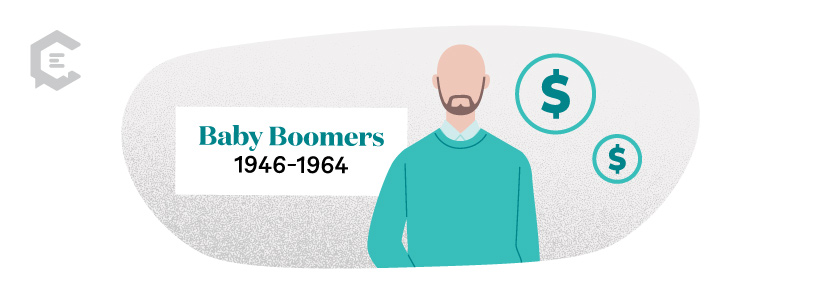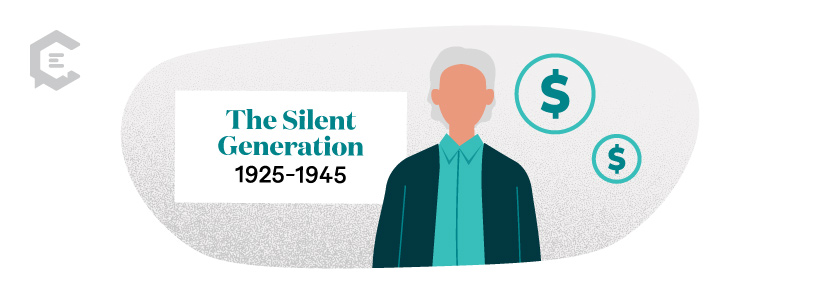Let’s see if this sounds familiar to you:
- The Silent Generation are frugal and conservative, valuing saving over spending.
- Baby boomers are willing to spend on leisure and luxury items without worrying about sustainability.
- Generation X is the forgotten middle child that is skeptical of marketing and values authenticity.
- Millennials are perpetually on their phones and don’t think twice about buying expensive coffee and avocado toast.
- Generation Z is the tech-savvy youngest child who is perpetually online while being highly socially and environmentally conscious.
All these stereotypes are pervasive but they’re exactly that: stereotypes. It’s a skewed perspective on the real values and spending behaviors of each generation. In this article, we’re going to shed an in-depth light on consumer spending by generation and break each group down.
Delving into Consumer Spending by Generation
In reality, millennials don’t do all of their shopping online, any more than baby boomers are necessarily extravagant. Nor does the Silent Generation hoard.
And, by the way, Generation X has a great deal of buying clout. Surprised? You won’t be, after taking a look at the following.
The U.S. Bureau of Labor Statistics compared expenditures between generations. Here is a general overview of average annual expenditures.
Food at home:
- Gen Z: $3,046
- Millennials: $5,008
- Gen X: $6,516
- Baby Boomer: $5,112
- Greatest Generation: $4,001
Food away from home:
- Gen Z: $2,483
- Millennials: $3,455
- Gen X: $3,872
- Baby Boomer: $2,539
- Greatest Generation: $1,486
Housing:
- Gen Z: $15,449
- Millennials: $$24,052
- Gen X: $26,385
- Baby Boomer: $21,273
- Greatest Generation: $16,656
Entertainment:
- Gen Z: $1,693
- Millennials: $3,457
- Gen X: $4,694
- Baby Boomer: $3,476
- Greatest Generation: $2,027
Apparel and services:
- Gen Z: $1,498
- Millennials: $2,135
- Gen X: $2,363
- Baby Boomer: $1,289
- Greatest Generation: $729
Pets:
- Gen Z: $369
- Millennials: $679
- Gen X: $949
- Baby Boomer: $842
- Greatest Generation: $495
Health care:
- Gen Z: $1,354
- Millennials: $4,026
- Gen X: $5,550
- Baby Boomer: $6,594
- Greatest Generation: $7,053
Here’s what’s interesting. The above numbers indicate that Gen X, the so-called “forgotten” generation, might be small, but its spending patterns are mighty. Mightier than those of millennials and baby boomers in most cases in fact.
Let’s find out more about Generation X.
Generation X: 1965-1980
According to PwC ‘s June 2023 Global Consumer Insights Pulse Survey, when looking at consumer spending by generation, only 28 percent of Gen Xers polled had acquired products via mobile/smartphones. McKinsey data bears this out, indicating that Generation X members have less intent to buy essential and non-essential items online. On the other hand, this age group does enjoy purchasing at-home streaming, book, and magazine services.
Speaking of intent to buy online in the near future, here’s what PwC learned about Generation X:
- 29% of those in this age group indicated they would spend more on takeout food
- 20% noted they’d spend money on fashion
- 20% will focus their purchase on health and beauty
- And 15% will spend money on travel
Unlike their baby boomer predecessors, Gen Xers approach each potential purchase with a great deal of skepticism. And, unlike their millennial successors, these adults focus on purchases that are unique and innovative. They’re into convenience and customization. They’ll also make use of search engines, online reviews, and social media networks before making a purchase.
To reiterate:
- Gen Xers delve into research before they buy; they use the internet to thoroughly research products (the majority use search engines above anything else).
- Many have yet to recover from the financial stresses of the Great Recession.
- They’re less likely to buy online than their successors.
- For such a small group, they evidence huge spending clout.
Speaking of successors, our next focus is on the Gen X younger brothers and sisters.
Millennials: 1981-1996
The typical millennial stereotype is, unfortunately, splashed all over mainstream and social media. They’re getting it from both of the generational sides. Above them, Gen X and Boomers give Millenials a hard time about $6 lattes and being upset that most of them can’t own a house. Below, Gen Z has already written them off as ancient.
The reality is somewhat different. Certainly, millennials grew up with technology at their fingertips. Many younger millennials would be hard-pressed to remember life before the World Wide Web. So, it should probably not come as a surprise that, according to PwC, a whopping 43 percent of millennials surveyed said they bought products and shopped weekly by mobile/smartphone.
As such, marketing to millennials is a smart move. Millennials, especially, have been likely to go online for essential items, such as groceries, household items, and personal care products. Millennials have also demonstrated the highest intent for entertainment at home and consumer electronics.
Additional online intent-to-purchase information notes that:
- 37% of millennials surveyed predict they’ll spend more money on takeout food
- 33% plan to buy more fashions and accessories
- 30% are focused on health and beauty spending
- 24% anticipate expenditures on travel
But, here’s a fun fact. millennials don’t want to always shop via the internet. For example, while they spend time on social media for research, they want the convenience of omnichannel accessibility to purchase.
They also like the social aspects of in-person shopping. If they can find a product they like in a brick-and-mortar store, that’s where they’ll head. In fact, younger millennials are more interested in the physical shopping experience than their older counterparts.
Here comes the summary of millennial buying habits:
- They’re less about online shopping, and more about the omnichannel experience.
- They’ll spend time online doing research, then determine different channels for purchasing.
- They’re interested in food spending, both takeout and in restaurants.
- A high percentage of millennial dollars is dedicated to entertainment.
Let’s move on to the newest cohort, Generation Z.
Generation Z: 1997-2012
If you’re looking at consumer spending by generation, you can’t skip Gen Z any longer.
Gen Z doesn’t know anything about life before the internet (except through stories). Additionally, a lot of them grew up in the shadow of the Great Recession and are entering the workforce in an economy that has been decimated by COVID.
And yes. They shop online. According to PwC, 35 percent of those surveyed in this age group shop online — daily. But they don’t just stay home and buy stuff on computers and mobile phones.
Much like their older millennial brothers and sisters, Gen Z shoppers like going to brick-and-mortar stores and looking around. To them, it’s a social excursion (malls are back). There is an instant gratification component to it as they get the thrill of not having to wait for it to be delivered.
What kind of stuff are they planning to buy online in the near term? According to PwC:
- 36% of those surveyed in this cohort expected they would spend more on takeout food
- 36% also noted they would spend more on fashion
- 32% pointed out they would spend money on health and beauty
- 26% indicated they would spend more on travel
You know what else is interesting? Generation Z members like luxurious things, but we aren’t looking at spendthrifts here. They’ve inherited careful spending habits from millennials and developed savings mindsets that will be in place well throughout their adulthood. They’re less susceptible to advertising about the next big thing.
So, to summarize Gen Z:
- They research online.
- They’re interested in luxury items to prove uniqueness.
- They want the shopping experience, and spend on eating out.
- They have a savings mindset.
Now let’s examine this cohort’s grandparents.
Baby boomers: 1946-1964
Here are more stereotypical comments about boomers. Selfish. Extravagant. Selfish (yes, we’re saying it twice). But none of this is true, especially when it comes to buying habits.
So, let’s get back to PwC. In the survey, 11 percent of baby boomers surveyed bought products via smartphones or tablets. Yes, this is a very small percentage, especially compared to the younger age groups analyzed here. And, according to McKinsey, boomers scored the lowest when it came to online intent to shop.
Furthermore, they aren’t likely to buy much more online, at least in the future. PwC found out that:
- 23% of boomers surveyed indicated they will spend more on takeout food
- 9% pointed out they would focus their spending on fashion
- 10% said they’d be spending more on health and beauty
- 13% indicated they’d spend more on travel
Unlike their children and grandchildren, baby boomers don’t like to shop. Even as they prefer in-person visits to stores, they’re not fans of browsing, or finding the best deals. They also don’t care about the social aspects of shopping. Given their disposable incomes, they haven’t felt the need to hunt out bargains.
So, to summarize:
- Until the pandemic, boomers were mainly bricks-and-mortar shoppers.
- They aren’t fond of shopping as an activity; they just want to get it done.
- They don’t feel the need to hunt out bargains.
- They still prize customer service over all else.
Who’s left? Baby boomers’ parents.
The Silent Generation: 1925-1945
Finally, we come to the oldest group in this article. When looking at consumer spending by generation, perhaps unsurprisingly (and once again, according to PwC), only 6 percent of those in the Silent Generation used a mobile or smartphone to purchase products. Even more so than their boomer children, members of this cohort are far more likely to prefer in-person shopping.
Many in the Silent Generation were born during the Great Depression and, as such, inherited financial conservatism. This doesn’t mean they’re frugal, or that they hoard and save every single thing. It does mean that they aren’t as willing to open up their wallets and spend. At least, not without good cause.
Specifically, here is the Silent Generation’s online intent-to-spend:
- 28% of those surveyed among this cohort indicated they are likely to spend more on takeout food
- 4% noted they would spend money on fashion
- 0% indicated they would spend money on health and beauty
- 14% are interested in directing their spending toward travel
And, here is a final fun fact. While many in the Silent Generation prefer in-person shopping, younger members of this group represent a fast-growing collection of internet users.
So, to summarize the Silent Generation:
- They rarely order from mobile phones or tablets.
- They do prefer in-person shopping.
- They’re less likely to spend impulsively.
- Younger members are using the internet more often.
Create Content Beyond the Stereotypes
Crafting content beyond generational preconceived notions requires in-depth research about their attitudes and preferences (including if and when they shift).
But let’s not forget that, despite the overreaching characteristics of consumer spending by generation, the people within these groups are just that: people. And a one-size-fits-all strategy might not work.
You need to make sure you’re creating content specifically tailored to the demographic you’re targeting, which means keeping your content plan versatile. At ClearVoice, we know a thing to two about customized content. Connect with us today to see how we can help you produce high-quality content that speaks to a generation (or two, or three).









